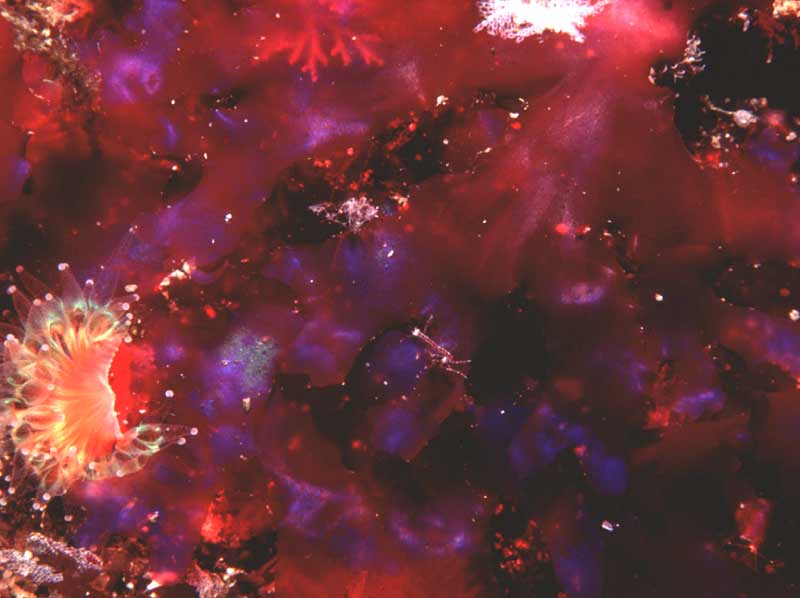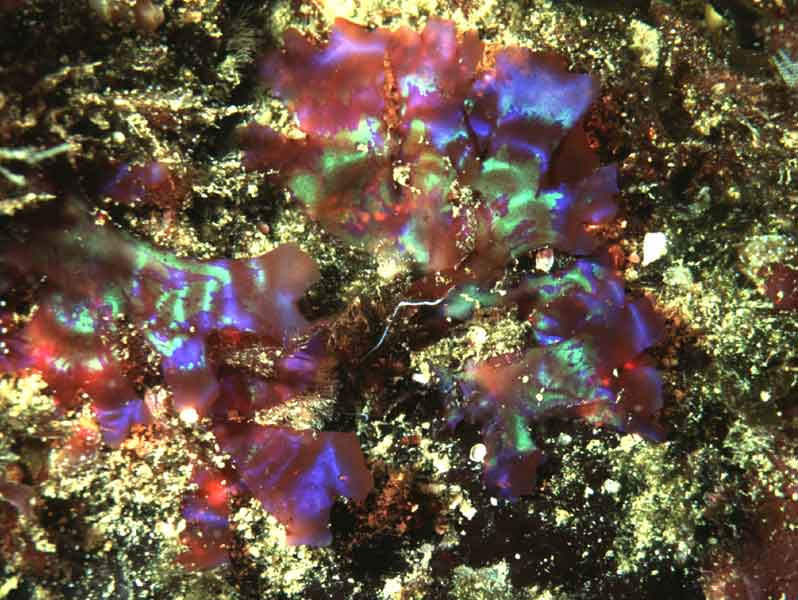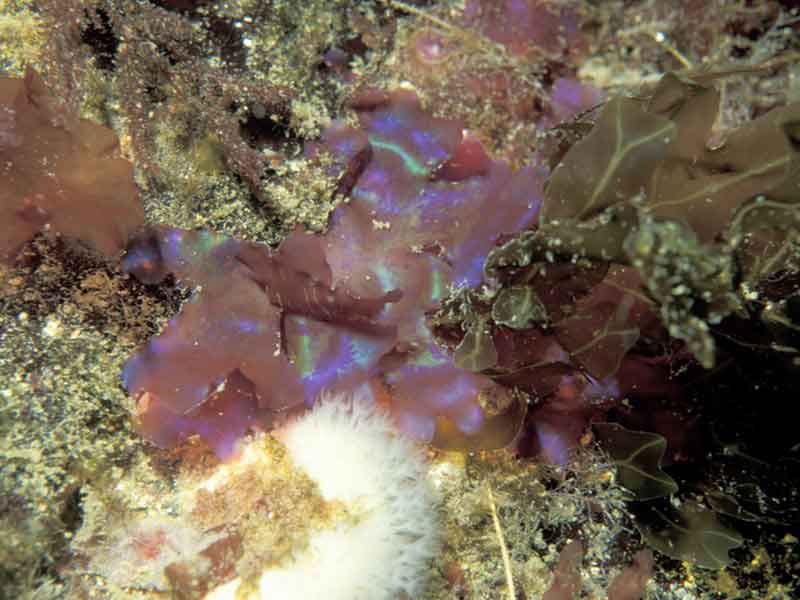Iridescent drachiella (Drachiella spectabilis)
Distribution data supplied by the Ocean Biodiversity Information System (OBIS). To interrogate UK data visit the NBN Atlas.Map Help
| Researched by | Olwen Ager | Refereed by | Admin |
| Authority | J.Ernst & Feldmann, 1957 | ||
| Other common names | - | Synonyms | - |
Summary
Description
Drachiella spectabilis is a foliose red algae that is dark rose to rosy purple in colour with a brilliant blue and purple iridescence underwater. The short stout stipe, which is about 1 cm long, widens into very thin, dichotomously branching, flattened fronds up to 7 cm in length. There is no distinct midrib. The blades recurve and attach to the substratum with root like outgrowths from the frond tips.
Recorded distribution in Britain and Ireland
Drachiella spectabilis has been recorded around south western and western coasts of the British Isles especially offshore islands and reefs.Global distribution
Found from the British Isles to northern France.Habitat
Large patches of Drachiella spectabilis are found on bedrock and boulders especially horizontal or gently sloping rock. It is found in Laminaria hyperborea forest and below the limit of kelp at sites exposed to moderate wave action.Depth range
2-30mIdentifying features
- Short, stout midrib (1cm long).
- Flattened, thin, dichotomously branching fronds (up to 7 cm long)
- Dark rose to rosy purple with brilliant blue and purple iridescence underwater.
- Root-like outgrowths from frond tips attach to substratum.
Additional information
-none-Listed by
- none -
Bibliography
Gibson, R., Hextall, B. & Rogers, A., 2001. Photographic guide to the sea and seashore life of Britain and north-west Europe. Oxford: Oxford University Press.
Guiry, M.D. & Nic Dhonncha, E., 2002. AlgaeBase. World Wide Web electronic publication http://www.algaebase.org,
Howson, C.M. & Picton, B.E., 1997. The species directory of the marine fauna and flora of the British Isles and surrounding seas. Belfast: Ulster Museum. [Ulster Museum publication, no. 276.]
JNCC (Joint Nature Conservation Committee), 1999. Marine Environment Resource Mapping And Information Database (MERMAID): Marine Nature Conservation Review Survey Database. [on-line] http://www.jncc.gov.uk/mermaid
Maggs, C.A. & Hommersand, M.H., 1993. Seaweeds of the British Isles: Volume 1 Rhodophycota Part 3A Ceramiales. London: Natural History Museum, Her Majesty's Stationary Office.
Picton, B.E. & Costello, M.J., 1998. BioMar biotope viewer: a guide to marine habitats, fauna and flora of Britain and Ireland. [CD-ROM] Environmental Sciences Unit, Trinity College, Dublin.
Datasets
Manx Biological Recording Partnership, 2017. Isle of Man wildlife records from 01/01/2000 to 13/02/2017. Occurrence dataset: https://doi.org/10.15468/mopwow accessed via GBIF.org on 2018-10-01.
Manx Biological Recording Partnership, 2022. Isle of Man historical wildlife records 1990 to 1994. Occurrence dataset:https://doi.org/10.15468/aru16v accessed via GBIF.org on 2024-09-27.
National Trust, 2017. National Trust Species Records. Occurrence dataset: https://doi.org/10.15468/opc6g1 accessed via GBIF.org on 2018-10-01.
NBN (National Biodiversity Network) Atlas. Available from: https://www.nbnatlas.org.
OBIS (Ocean Biodiversity Information System), 2025. Global map of species distribution using gridded data. Available from: Ocean Biogeographic Information System. www.iobis.org. Accessed: 2025-05-09
Royal Botanic Garden Edinburgh, 2018. Royal Botanic Garden Edinburgh Herbarium (E). Occurrence dataset: https://doi.org/10.15468/ypoair accessed via GBIF.org on 2018-10-02.
Citation
This review can be cited as:
Last Updated: 01/07/2003





